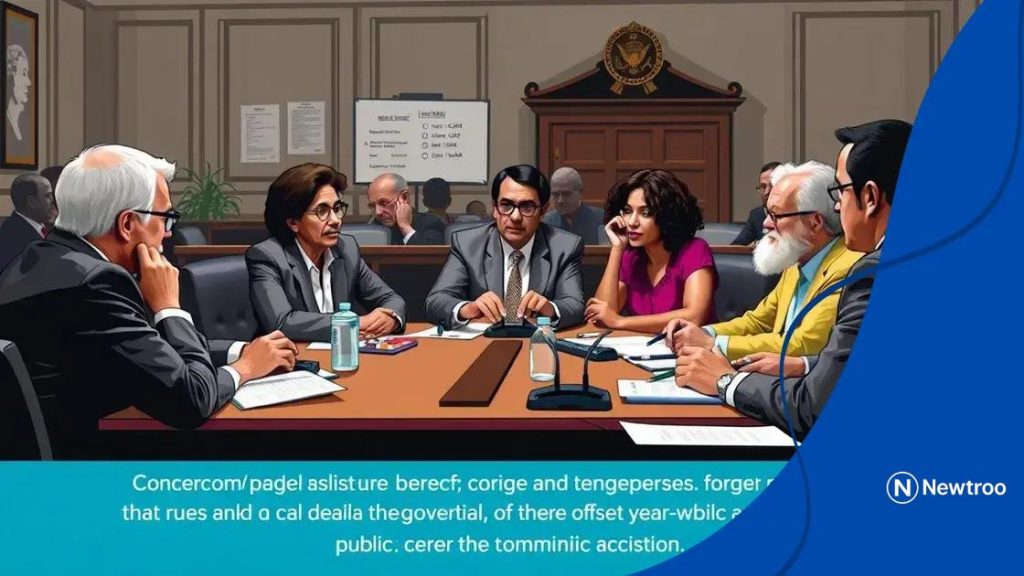House budget panel proposes reduction in public assistance

Anúncios
The House budget panel proposes reductions in public assistance, significantly impacting vulnerable groups like low-income families, children, the elderly, and individuals with disabilities.
House budget panel proposes reduction in public assistance amidst growing concerns about economic stability. This move could affect countless families, raising questions about support systems and financial stability. What does this mean for those relying on these services?
Anúncios
Overview of the proposed budget changes
The recent proposals from the House budget panel revolve around changes that directly impact public assistance programs. Many are concerned about how these reductions will affect vulnerable populations, especially during a time of economic uncertainty.
Overview of the budget cuts:
Key Changes Proposed
The panel has outlined several significant changes in the budget that could reshape support for countless families. These alterations aim to reduce spending but raise critical questions about the safety net for those in need.
Anúncios
Potential Impacts
It’s essential to consider who will face the brunt of these reductions. Many low-income families, the elderly, and individuals with disabilities might struggle more than ever. Understanding these implications is vital for ensuring community support.
- Decrease in financial aid for low-income families
- Potential cuts to healthcare and food assistance
- Reduction in housing assistance programs
- Increased barriers in accessing social services
As the situation evolves, ongoing discussions about the future of public assistance will play a crucial role. Advocacy groups are already mobilizing to address these concerns and highlight the urgency for maintaining adequate support.
The focus on these budget cuts underscores a national conversation about priorities and the type of society we wish to foster. Balancing budget efficiency with support for the needy is undoubtedly a challenging task for lawmakers.
The Role of Advocacy
Community responses increase pressure on the panel to reconsider these cuts. Advocates emphasize the need for empathetic policies that consider the consequences of budget decisions. The pushback from local organizations shows the essential role of civic engagement in shaping public policy.
By staying informed and involved, individuals can help ensure that the voices of those affected by the proposed budget changes are heard. Observing how these discussions unfold will be critical in the coming months.
Key reasons behind the budget cut
Understanding the key reasons behind the budget cut proposed by the House panel is crucial for grasping its implications. There are several significant factors that have led to these decisions.
Economic Pressures
One primary reason for the cuts is the growing economic pressures facing the government. With rising national debt and increasing demands on government resources, officials often find it necessary to streamline spending. This has led to tough choices impacting public assistance.
Shift in Policy Focus
Another important factor is a shift in policy focus. Lawmakers may prioritize areas they believe will yield greater returns or benefits. Resources are increasingly being directed toward initiatives seen as essential for economic growth, potentially at the expense of direct assistance programs.
- Focus on infrastructure and job creation
- Investment in education and technology
- Reducing waste and inefficiencies in other programs
The political landscape also plays a role. With varying opinions among lawmakers, compromises often lead to cuts in less popular areas, such as public assistance. These decisions can result from conflicts between different political ideologies and priorities.
Response to Demand
Response to changing public demand also influences budget decisions. As the government faces input from constituents regarding where funds should be allocated, lawmakers may react to feedback that suggests a desire for spending shifts. Engaging the public on these matters shows the balancing act between immediate community needs and long-term policy goals.
In summary, a mixture of economic realities, policy shifts, political negotiation, and constituent pressures contribute to the reasons behind the proposed budget cuts. Each factor highlights the complexity of budgetary decisions and the ongoing discussion about the best ways to support those in need.
Who will be affected by the reductions?

Analyzing who will be affected by the reductions in public assistance is critical to understanding the broader impact of the proposed budget changes. These cuts are likely to touch various groups in society, causing significant challenges for many.
Low-Income Families
One of the most vulnerable populations consists of low-income families. These households often rely heavily on public assistance programs for their basic needs, including food, housing, and healthcare. A reduction in funding could mean that many families might struggle to make ends meet, affecting their overall well-being.
Children and Youth
Additionally, children and youth will feel the impact of these budget cuts. Programs that provide essential services, like free or reduced-cost meals at schools, could face cutbacks. This can lead to increased food insecurity among children, which may hinder their growth and development.
- Decreased access to nutritious meals
- Interruptions in educational programs and support
- Increased risk of health issues
The elderly population is another group that could be significantly affected. Many senior citizens depend on assistance for health care costs and daily living expenses. Cuts to these programs may force them to make difficult choices about their health and financial security.
Individuals with Disabilities
People with disabilities are also at risk due to the proposed reductions. Support services that help them live independently may face diminishing resources, leading to increased isolation and decreased quality of life. It’s vital to ensure that all community members have access to necessary support regardless of their circumstances.
As these reductions take effect, understanding exactly who will be affected becomes essential. The ripple effects could escalate tensions within communities and highlight the need for advocacy to protect those who are most at risk.
Potential alternatives to public assistance
Exploring potential alternatives to public assistance is essential in light of the proposed budget cuts. These alternatives aim to provide support for those in need while reducing the burden on government resources.
Community-Based Programs
One effective alternative is the development of community-based programs. These programs leverage local resources to help individuals and families. By focusing on community engagement, such initiatives can offer tailored support and foster a sense of belonging.
- Food banks and community kitchens
- Job training and employment services
- Local mentorship programs
Another approach is to enhance non-profit organizations that specialize in addressing specific needs. These organizations often have a grassroots understanding of the local issues faced by residents and can mobilize resources quickly. Non-profits can provide targeted assistance that may not be available through traditional public aid.
Public-Private Partnerships
Public-private partnerships can also serve as a viable alternative. By combining efforts with businesses, government entities can create programs that promote economic growth while providing essential services. Such collaborations can enhance job training programs, increase access to affordable housing, and stimulate local economies.
For instance, partnerships with local businesses can lead to apprenticeship programs that develop skills for job seekers, thus encouraging employment without heavy reliance on public funding.
Increased Focus on Education and Skill Development
A shift towards education and skill development can reduce the need for continuous public assistance. By investing in educational opportunities, communities can empower individuals to achieve sustainable employment. Emphasizing vocational training and continuing education can lead to better job prospects and independence.
It is important to explore a mix of these alternatives to effectively address the needs of those affected by the cuts to public assistance. Implementing a combination of solutions can create a more resilient support network for individuals and families, allowing them to thrive without depending solely on government aid.
Public reaction and next steps for advocacy
Understanding public reaction and next steps for advocacy in response to proposed budget cuts is vital for shaping future policy. The community response highlights concerns and mobilizes support for those who may be affected.
Public Outcry
Many community members have expressed their discontent regarding the reduction in public assistance. Social media campaigns, local protests, and petitions have emerged as common avenues for individuals to voice their opinions. People are rallying around the idea that support programs are essential for maintaining a healthy society.
Advocacy Groups in Action
Advocacy groups play a critical role in bringing attention to these budget cuts. These organizations are leveraging data to inform the public about the potential negative impacts of the reductions. They are pushing for alternative solutions to protect the vulnerable populations that depend on assistance.
- Organizing community forums to discuss concerns
- Sharing stories from individuals affected by cuts
- Lobbying local representatives for amended budget proposals
The collaboration between community members and advocacy organizations is crucial. By uniting efforts, they can present a stronger front to policymakers. This collaboration focuses on educating lawmakers about the real-life implications of their decisions.
Next Steps
Looking ahead, it is essential for communities to remain engaged. Organizing informational workshops where residents can learn how to advocate for themselves is one way to promote awareness. Additionally, building coalitions with other organizations can amplify their message and impact.
Communities can also utilize social media platforms to keep the momentum alive. Regular updates about advocacy efforts and success stories can inspire others to join the cause. Keeping the conversation ongoing ensures that the challenges faced by those dependent on public assistance remain visible.
By highlighting public concern and outlining actionable steps, citizens can push for changes that protect essential support systems. Awareness and action are key to ensuring that those most affected have a voice.
FAQ – Frequently Asked Questions about Public Assistance Budget Cuts
What are the main impacts of the proposed budget cuts on public assistance?
The proposed budget cuts are likely to affect low-income families, children, the elderly, and individuals with disabilities, leading to increased hardship for these groups.
How can community members advocate against these budget cuts?
Community members can organize forums, engage in social media campaigns, and collaborate with advocacy groups to raise awareness and pressure lawmakers.
What are some alternatives to public assistance programs?
Alternatives include community-based programs, public-private partnerships, and a focus on education and skill development to help individuals gain independence.
What role do advocacy groups play in addressing these cuts?
Advocacy groups inform the public about the implications of the budget cuts, mobilize support, and lobby for negotiations to protect essential services.